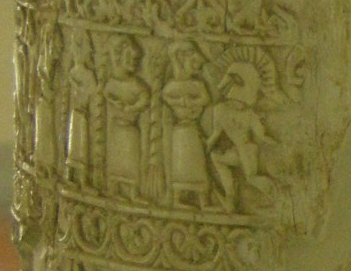Situla Of The Pania on:
[Wikipedia]
[Google]
[Amazon]

 The Situla of the Pania is an
The Situla of the Pania is an
 The Situla of the Pania is an
The Situla of the Pania is an ivory
Ivory is a hard, white material from the tusks (traditionally from elephants) and teeth of animals, that consists mainly of dentine, one of the physical structures of teeth and tusks. The chemical structure of the teeth and tusks of mammals is ...
situla
Situla (plural ''situlae''), from the Latin word for bucket or pail, is the term in archaeology and art history for a variety of elaborate bucket-shaped vessels from the Iron Age to the Middle Ages, usually with a handle at the top. All types ma ...
or pyxis
Pyxis is a small and faint constellation in the southern sky. Abbreviated from Pyxis Nautica, its name is Latin for a mariner's compass (contrasting with Circinus, which represents a draftsman's compasses). Pyxis was introduced by Nicolas-Lo ...
from the end of the seventh century BC, found in the Tomb of the Pania in Chiusi
Chiusi (Etruscan: ''Clevsin''; Umbrian: ''Camars''; Ancient Greek: ''Klysion'', ''Κλύσιον''; Latin: ''Clusium'') is a town and ''comune'' in the province of Siena, Tuscany, Italy.
History
Clusium (''Clevsin'' in Etruscan) was one of t ...
and conserved in the Museo archeologico nazionale di Firenze.
The work is one of the most important examples of Etruscan __NOTOC__
Etruscan may refer to:
Ancient civilization
*The Etruscan language, an extinct language in ancient Italy
*Something derived from or related to the Etruscan civilization
**Etruscan architecture
**Etruscan art
**Etruscan cities
** Etrusca ...
ivory work - there are only two other examples, one from Chiusi and one from Cerveteri
Cerveteri () is a town and ''comune'' of northern Lazio in the region of the Metropolitan City of Rome. Known by the ancient Romans as Caere, and previously by the Etruscans as Caisra or Cisra, and as Agylla (or ) by the Greeks, its modern name de ...
. It is composed of a hollow cylinder (22 cm high) and decorated with horizontal friezes, separated by small bands carved with plant motifs (interweaved palmettes and lotus flowers). Two medium-sized bands at the top and bottom are decorated with more lotus flowers.
The upper frieze shows two myths from the Odyssey
The ''Odyssey'' (; grc, Ὀδύσσεια, Odýsseia, ) is one of two major Ancient Greek literature, ancient Greek Epic poetry, epic poems attributed to Homer. It is one of the oldest extant works of literature still widely read by moder ...
, split by a sphinx
A sphinx ( , grc, σφίγξ , Boeotian: , plural sphinxes or sphinges) is a mythical creature with the head of a human, the body of a lion, and the wings of a falcon.
In Greek tradition, the sphinx has the head of a woman, the haunches of ...
: the encounter with Scylla
In Greek mythology, Scylla), is obsolete. ( ; grc-gre, Σκύλλα, Skúlla, ) is a legendary monster who lives on one side of a narrow channel of water, opposite her counterpart Charybdis. The two sides of the strait are within an arrow's r ...
(who looks a lot like a hydra) and the escape from the cyclops
In Greek mythology and later Roman mythology, the Cyclopes ( ; el, Κύκλωπες, ''Kýklōpes'', "Circle-eyes" or "Round-eyes"; singular Cyclops ; , ''Kýklōps'') are giant one-eyed creatures. Three groups of Cyclopes can be distinguish ...
Polyphemus
Polyphemus (; grc-gre, Πολύφημος, Polyphēmos, ; la, Polyphēmus ) is the one-eyed giant son of Poseidon and Thoosa in Greek mythology, one of the Cyclopes described in Homer's ''Odyssey''. His name means "abounding in songs and lege ...
. The second frieze shows common motifs of departure for war, followed by hoplite
Hoplites ( ) ( grc, ὁπλίτης : hoplítēs) were citizen-soldiers of Ancient Greece, Ancient Greek Polis, city-states who were primarily armed with spears and shields. Hoplite soldiers used the phalanx formation to be effective in war with ...
s performing a salute and weeping women (with long braids and their arms over their chests). After that there is a warrior without his shield performing a funerary dance and a horseman. The third band is decorated with beasts and monsters, employing eastern motifs. On the final band there are further imaginary animals.
The style of the situla is less monumental than ivories of the previous period, but more lively.
Bibliography
*Ranuccio Bianchi Bandinelli
Ranuccio Bianchi Bandinelli (19 February 1900 – 17 January 1975) was an Italian archaeologist and art historian.
Biography
Bianchi Bandinelli was born in Siena to Mario Bianchi Bandinelli (1859–1930) and Margherita Ottilie "Lily" von Korn ...
& Mario Torelli, ''L'arte dell'antichità classica, Etruria-Roma'', Utet, Torino 1976.
{{Commons category, Situla della Pania
Etruscan artefacts
Ivory works of art
National Archaeological Museum, Florence
Chiusi